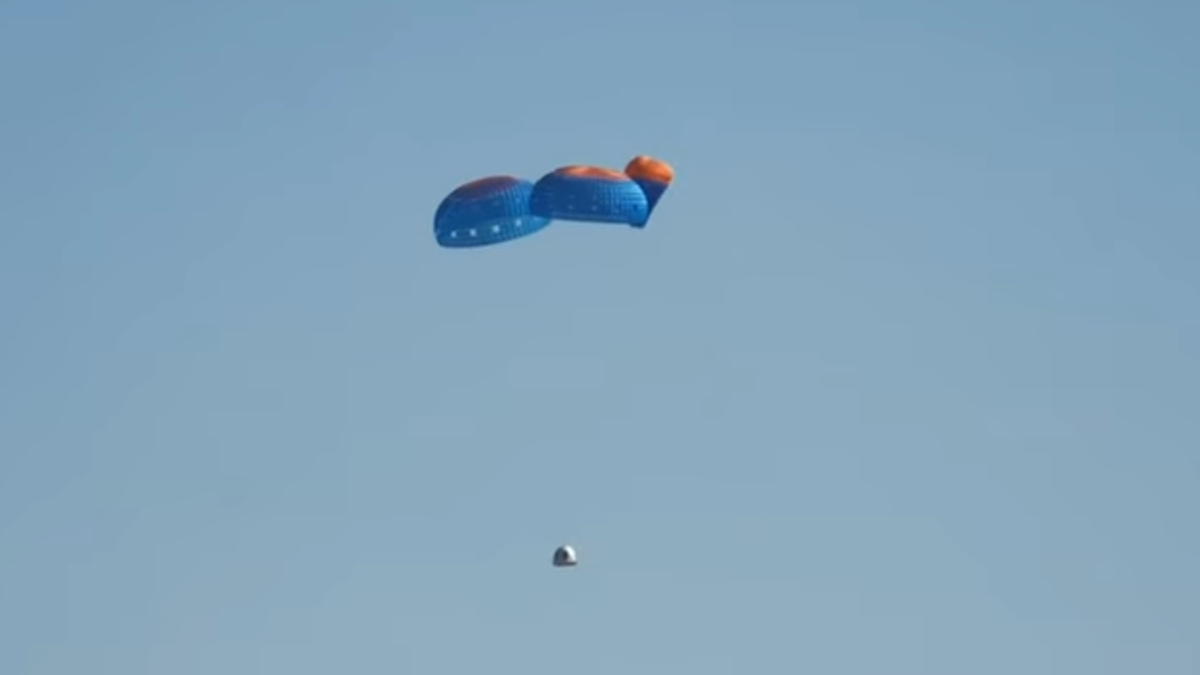Blue Origin, the company founded by Amazon billionaire Jeff Bezos, has launched an investigation after an incident during its first crewed flight in two years in which one of the parachutes on the New Shepard capsule failed to fully inflate.
to the company The new Shepard rocket was launched on May 19 carrying a crew of six into suborbital space. The NS-25 mission saw the crew capsule descend to end the flight, but only two of its three parachutes were fully inflated, SpaceNews reported. Steve Stich, NASA’s commercial crew program manager, recently revealed the issue during a briefing on the upcoming Boeing Starliner crew test flight. Blue Origin had not made the issue with its parachute public, but instead informed NASA officials about the anomaly since vehicles such as Boeing’s Starliner use similar components.
New Shepard uses three parachutes to slow the crew capsule as it returns to Earth, although it can land with only one parachute fully deployed. The parachutes are designed to deploy in three stages, but during the NS-25 mission, one of the three parachutes failed in the first stage when a line controlling its inflation did not cut as intended, according to Stich.
“It’s a small group of people who work on these parachutes,” Stich was quoted as saying by SpaceNews. “They’ve been great about sharing data with us. They don’t have any kind of root cause yet, and we continue to follow along with them.”
Bezos’ private space venture restarted its space tourism program with the NS-25 mission nearly two years after its rocket touched down. In September 2022, one New Shepard’s uncrewed flight ended in flames about a minute after take off. The rocket’s booster exploded mid-flight and its capsule abandoned the ship while traveling at about 700 miles per hour (1,130 kilometers per hour) and at 29,000 feet (8,840 meters) above the ground.
Blue Origin identified a “thermo-structural failure of the engine nozzle” as the reason for the failed missile launch. At the time, New Shepard was carrying 36 payloads, more than half of which belonged to NASA, but there was no crew aboard the capsule. The company resumed its space tourism operations with the seventh human spaceflight on May 19, marking a comeback after the previous liftoff malfunction. We do not yet know the severity of the parachute problem or whether it will cause further delays. While we’re no parachute experts, it’s fair to say that this is a concern; if a parachute fails to deploy, it can indicate the potential for multiple failures during descent.
In addition, engineers in the Boeing Starliner program discovered their own parachute problem, one that delayed the first crewed flight of the capsule. A few weeks before the scheduled liftoff on July 21, 2023, Starliner crews discovered that the fabric parts of the parachutes had a lower failure load limit than expected. This meant that if one parachute failed, the other two would not be able to slow the Starliner vehicle down enough for a safe landing in New Mexico. In March 2024, Boeing announced that it had resolved the security issue.
The problem with parachutes stems from the difficulty in accurately simulating the environment in which they are deployed. “Even today, with all the technology we have and everything else, as far as we’ve come with parachutes, we still can’t model an inflatable parachute,” Stich said, according to SpaceNews. “It seems like it should be easy. It’s still a little difficult.”
For more space flights in your life, follow us X and bookmark Gizmodo’s dedicated Spaceflight Page.
